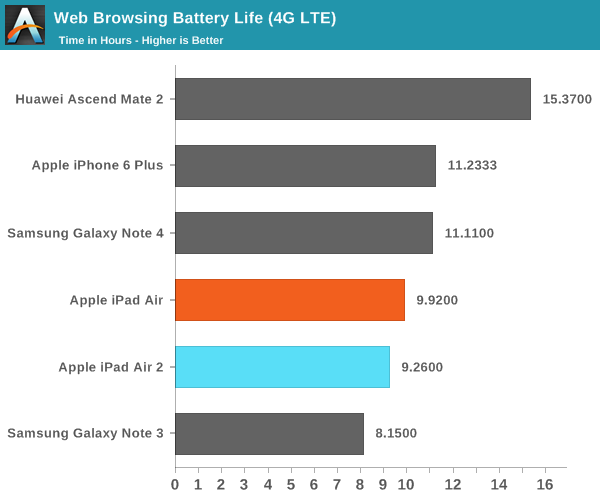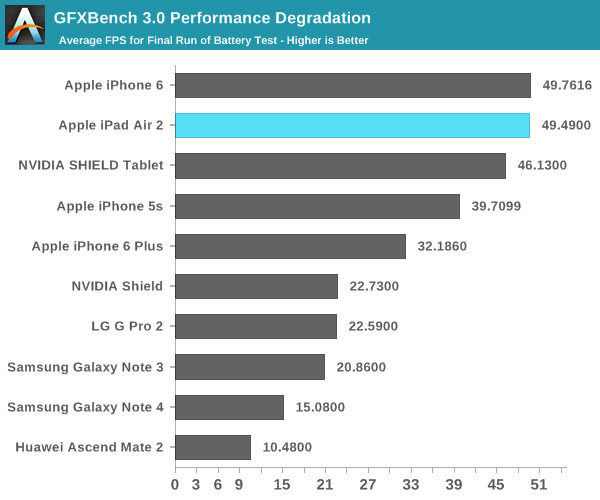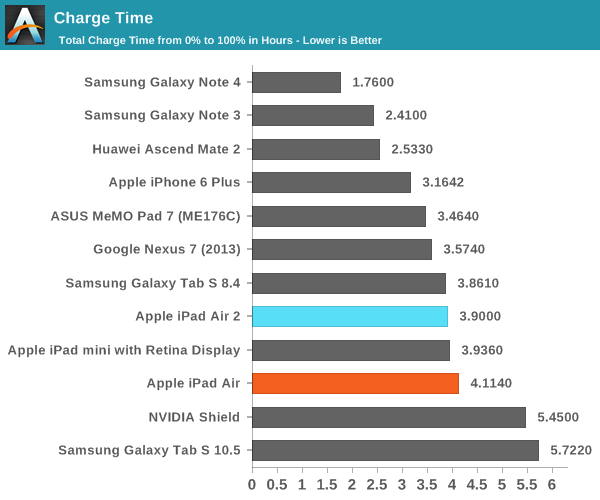The Apple iPad Air 2 Review
by Joshua Ho on November 7, 2014 9:30 AM EST- Posted in
- Tablets
- Apple
- Mobile
- iOS
- ipad Air 2
Battery Life
With the move from featurephones to smartphones, battery life has been and continues to be a critical issue. While it wasn’t unusual to see a week or more of battery life on a featurephone, some of the earliest smartphones couldn’t even last a day. While tablets seem to have a much easier time achieving high levels of battery life by virtue of massively increased volume, they still face similar issues as they are often used for gaming or other more intensive workloads that a smartphone is unlikely to see nearly as often. In order to test this, we run our tablets through a standard suite of tests of various use cases. In all cases where the display is on, all displays are calibrated to a brightness of 200 nits to draw useful relative comparisons.

In our first test, we see that the iPad Air 2 is about roughly equivalent to the original iPad Air for WiFi web browsing. This is actually a bit surprising as the battery in the iPad Air 2 is approximately 84% of the iPad Air. This would mean that we would expect the iPad Air 2 to get around 8.4 hours of battery life in this test, which represents a 16% gain to efficiency. It’s likely that these improvements to battery life come from the new process node on the A8X, along with the newer WiFi module.

Along the same lines, the LTE web browsing test tracks quite closely but it seems that there’s a minor decrease in efficiency gains when compared to WiFi. This difference is likely to be explained by the much higher bandwidth available in WiFi when compared to LTE.
While the web browsing tests are effective at ensuring faster SoCs aren’t punished, this inherently tilts battery life towards a more display-bound mode rather than compute-bound. Unfortunately short of a jailbreak it doesn’t seem possible to get an effective Basemark OS II battery test, so we’re mostly limited to a test of GFXBench’s unlimited rundown.


As one can see, the iPad Air 2 is one of the best performers on this test, considering its frame rate and runtime. While NVIDIA's GK20A GPU in Tegra K1 can get close to the GX6650 for short periods of time, over a long workload it's pretty clear that the GX6650 on 20nm has better sustained performance and significantly superior efficiency as it doesn't throttle until the 200th iteration of the test. It's important to note that the iPad Air 2 is running at a higher native resolution here, so relative to SHIELD Tablet a scaling factor needs to be estimated in order to get an idea for performance at the same resolution. During this test I saw that the skin temperatures never exceeded 45C, so this isn't the result of Apple choosing to run the device hotter than most.
Charge Time
While tablets deliver some great battery life in general, charge time tends to be much slower than that of smartphones as the battery is much larger and charging the device isn't as time critical due to the longer battery life . While we can't quite cover the full range of battery life uses cases, it's important to remember that in cases where the platform is otherwise identical beyond display that battery life scales linearly with overall capacity. In order to test charge time, we measure the time it takes for the battery to reach 100% from a fully-depleted state.

As one can see, the smaller battery seems to have a noticeable impact on charge time, although the difference isn't really all that notable as the difference is only around ten minutes at the end of the day.











226 Comments
View All Comments
name99 - Friday, November 7, 2014 - link
Roughly Haswell IPC is equal to Apple IPC. There are lots of caveats to this --- Apple does better on Geekbench, Intel does better on SPEC (probably because they have a superior memory system). Intel also have, to be fair, a much more mature compiler, while Apple can probably squeeze another 10% out of LLVM for ARM64 over the next year or two, along with some improvements to the SPEC numbers when their long awaited polyhedral optimizations finally go mainstream.I used to think Apple would ramp to higher frequencies, now I think a different trajectory is more likely. An Intel CPU is a bundle of many capabilities, and the CPU part is only one of these. There's also, for example, the turboing subsystem, and the profiling/debugging subsystem. My guess is that they are (even though they have said nothing about it) headed for the same sort of HSA future that AMD talks about.
I expect over the next few years, much Apple work will go into this sort of less than sexy infrastructure, stuff that Apple won't talk about much (if at all) and it will only make its appearance in things like better XCode tools and much less overhead to transfer code and data between CPU and GPU. Looking at the competitive landscape, Apple look like they could get away with an A9 improvement that's to the A8 as the A8 is to the A7 --- a steady 25%, one third from compiler, one third from another 100 or 150MHz boost, and one third from more tweaking of the CPU.
It's possible that this is indeed what we should expect because I'd guess that Apple's A-team for CPU design is hard at work on the AWatch project, and probably following the same strategy as we saw with CPUs --- the S1 will probably be a good but not spectacular SoC, something reliable to get the project rolling, the equivalent of A5. S2 will presumably be a substantial jump, with all the less risky optimizations they couldn't fit into S1, while S3 will knock it out of the park, taking the risk of project slippage to make use of every good idea the team has.
If this theory is correct, It may not be until A10 or so, as the team has hired more people and the watch project becomes more stable, that we get a rethinking of the phone/tablet CPU.
[Of course by then, who knows, maybe Apple will have announced iDust and mote CPUs will be what their CPU A-team are working on?]
anquietas - Friday, November 7, 2014 - link
Good perspective! This sounds lIke exactly how Apple would operate.iwod - Saturday, November 8, 2014 - link
This. Most people when comparing ARM64 SoC to Intel often fail to count the difference between the software ecosystem. Intel had much more engineers and years of optimization in libraries, and compiler. There are still quite lot of work to do on ARM64 and LLVM.JoshHo - Friday, November 7, 2014 - link
While we haven't included the Surface Pro 3 in comparisons as it's a much more expensive device, all of the tests in this review and more have been released to Bench where you can compare the two SoCs.ABR - Friday, November 7, 2014 - link
Just got back from checking the iPad Air at a store, and the performance was disappointing to say the least. I've got an iPad 2, and I keep reading about these leaps and bounds in the SOCs each year, but when it comes to a real-world task like opening the Mail app or paginating a novel in iBooks, this supposedly mind-blowingly smoking device is only incrementally faster than my 2nd gen clunker. What gives?I thought maybe everything was being bottlenecked by the flash access, but Josh tested that too and of course it looked way ahead of earlier hardware in that area too. iOS slowdowns? I'm running 7 instead of 8 on the Air 2, but that's only one generation behind.
Anyone have any idea what the deal is?
rUmX - Friday, November 7, 2014 - link
You need to be performing more intensive tasks to see the huge peperformance differences, as benchmarks show. Opening mail is not very demanding.ABR - Friday, November 7, 2014 - link
I guess you're saying maybe there's a floor effect with Mail opening given by the animation timers if nothing else, but how do you explain iBook pagination? That takes several seconds and seems to be computatin limited.Sushisamurai - Friday, November 7, 2014 - link
If u can't tell a difference, then maybe u should hold onto your iPad 2. I sold my iPad2-32GB wifi model for $200, just to upgrade to this Air 2. My iPad2 was stuttering and dropping frames for the apps I was using (also on iOS8). This Air 2 is absolutely amazing compared to the iPad2 - some of my daily apps can load, and reload (after downloading a minor update), before my other iPad2 finishes loading LOLABR - Saturday, November 8, 2014 - link
Maybe it's iOS 8 then. Good way to sell hardware. The big performance drop going to 7 is one of the reasons I'm not going any further yet. I'd get the Air 2 for the weight, retina, and fingerprint, not the SOC, but the way it runs hot is a big downgrade.Streamlined - Friday, November 7, 2014 - link
FYI, I was doing some financial analysis on Apple and the iPad Air 2 cost structure and I'm estimating that the "Apple Tax" on these is probably only a little more than $100 per unit on the 16gb wifi model.Read the details at www.perezonomics.com